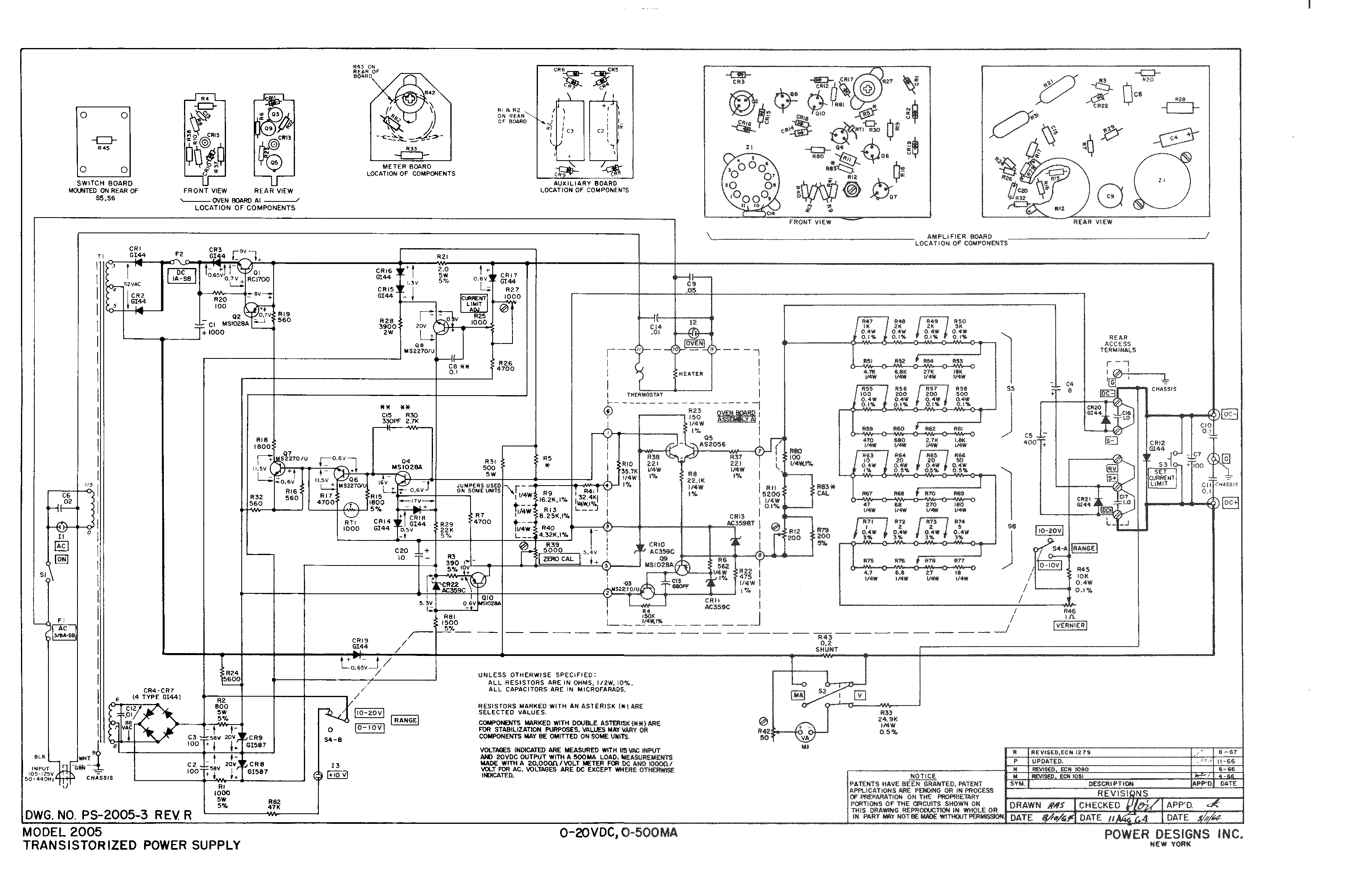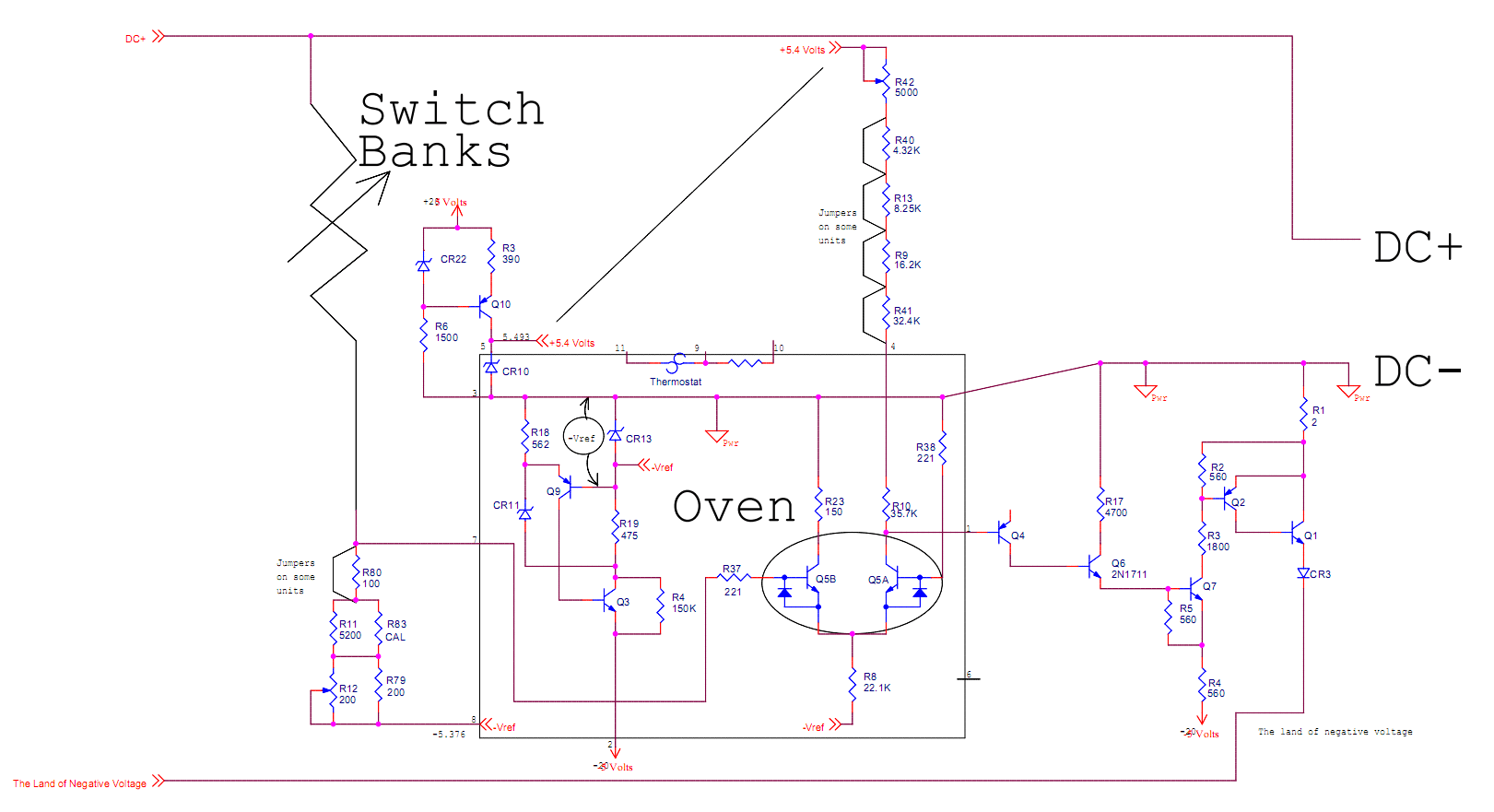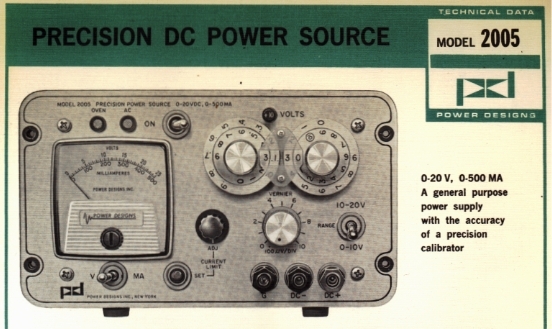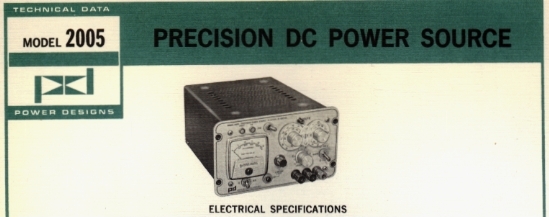| Print, video, sounds |
|
 . I redrew the basic schematic in Orcad using the fundamental schematic drawing rules: Inputs on the left, outputs on the right and higher voltage towards the top. The cryptic Power designs schematic became clear at once.  . Sure enough, once I drew just a rough overview if the schematic, it became obvious I had a problem in the switch array. The electronics were fine. Here is a pdf of my redrawn schematic. Here is a zip file of the OrCAD 9.3 Capture file. This goes to show the importance of a properly drawn schematic. That means inputs on the left and top, outputs on the right and bottom. Put positive voltages above grounds and common, and negative voltage below them. And don't try to show the pin-out of parts. This is the scheme of things, not the layout of things, That is a whole different document. So here is the factory manual (pdf of a newer model): |
 |
  |
 . New high-stability, low-noise silicon semiconductor devices and advanced solid-state circuit technology are the basis for this unusually stable voltage regulator. The improved performance of the Model 2005 permits dial readout of the output voltage to five places. Interpolation of the last place is provided by a potentiometer with a resolution of 10 microvolts. Conventional, more complex chopper techniques for DC amplifier stabilization are avoided by maintaining critical amplifier stages and a specially processed zener diode voltage reference in a temperature-controlled oven. The design simplicity results in a low-cost unit, half the size and weight of comparable instrumentation. Design Features of the Model 2005P
|
 |
  |
 .
|
 |
  |
|
Electrical specifications (con't)
|
 |
  |
 MECHANICAL SPECIFICATIONS MECHANICAL SPECIFICATIONS
|
 |
  |
 . PRECISION DC POWER SOURCE MODEL 2005 SECTION 1 GENERAL DESCRIPTION 1-1. DESCRIPTION The Model 2005 is a precision DC power source designed to supply an extremely stable 0 to 20 volt, 0 to 500 milliainpere output. The instrument combines the accuracy of a precision calibrator with the power capability of a general-purpose regulated supply. Two dual, concentric decade switches provide a digital readout of the selected output voltage to within 0.1% +1 millivolt of the selected value. A 1-millivolt range, single-turn potentiometer permits interpolation of the last place. This potentiometer has a resolution of 10 microvolts. A toggle switch selects the range of the dial readout; either from 0 to 10 volts, or from 10 to 20 volts. The output voltage of the supply may be remotely programmed with the same accuracy, using an external resistance. The supply also includes provisions for remote sensing of the output voltage at the load. Compact and light, the power source is self-contained in a portable housing designed for bench use. The modular construction of the Model 2005 makes it suitable for rack mounting. Panel adapters are available for mounting one or two units in a standard 19-inch rack having a panel height of 5 1/4 inches. |
 |
  |
|
 | ||||||||||||||||||
  |
|||||||||||||||||||
(con't) |
 | ||||||||||||||||||||||||
  |
|||||||||||||||||||||||||
|
 | ||||||||||||||||||
  |
|||||||||||||||||||
|
PRECISION DC POWER SOURCE MODEL 200 SECTION 2 INSTALLATION AND OPERATION 2-1. INSTALLATION
|
 |
  |
|
2-2. OPERATION
|
 |
  |
|
 |
  |
|
 |
  |
SECTION 3 PRINCIPLES OF OPERATION 3-1. GENERAL The Model 2005 is a highly accurate, series regulated, DC voltage source. Basically, it consists of a full-wave rectifier circuit, a series regulator circuit and a current limiting circuit. The series regulator circuit is essentially an electronically variable resistance interposed between the unregulated source and the load. The resistance value is controlled by an amplifier which compares the source output voltage with a reference voltage. The amplifier adjusts the series resistance to reduce the error signal to zero. |
 |
  |
|
The reference voltage is generated by an internal auxiliary power source. The error
signal resulting from the voltage comparison is amplified and applied through a driver stage to the series transistor to vary its effective
resistance. 3-2. FULL-WAVE RECTIFIER OPERATION The full-wave rectifier consists of diodes CR1 and CR2. Its output is applied through fuse F2 to series regulator transistor Q1. The output of the full-wave rectifier is filtered by capacitor C1. 3-3. SERIES REGULATOR OPERATION The series regulator circuit consists of differential amplifier Q5, amplifiers Q4, Q6 and Q7; driver Q2 and series regulator Q1. The voltage reference for the differential amplifier is zener diode CR13. A constant current is maintained through CR13 by transistors Q9 and Q10 and zener diode CR11. These components are powered by an auxiliary 20-volt supply. The constant voltage across CR13 is impressed across the base- emitter junction of one half of Q5. Potentiometer R12 is adjusted to bias the base-emitter junction of the input half of Q5 to the same potential. Zener diode CR10 provides a constant collector voltage for the input section of the differential amplifier. A constant current for this zoner diode is provided by CR22 and Q10, which are powered by an auxiliary 20 volt supply. The differential amplifier, its voltage reference and the transistors which maintain a constant current through the voltage reference are located on oven board assembly A1. The oven maintains these components in a constant-temperature environment to provide highly stable operation. |
 |
  |
|
The input to the differential amplifier is applied from a voltage divider
across the supply output. Any change in output voltage changes the bias on the differential amplifier and, consequently, changes the collector
current on the output half of this stage. This changes the drive on amplifiers Q4, Q6, and. Q7. The changed output of Q7 changes the drive
of Q2, and therefore of series regulator Qi. This change in drive on Q1 is in the correct direction to oppose any change in the supply output
voltage. For example, if the output voltage tends to increase, the forward bias on the input stage of the differential amplifier increases. This reduces the collector current of the output half of this stage, reducing the drive of amplifiers Q4, Q6, and Q7. The reduced collector current of Q7 lowers the forward bias of driver Q2. The reduced collector current of Q2 reduces the forward bias of series regulator Q1, increasing its effective resistance. The increased resistance of Q1 increases the voltage drop across it, reducing the output voltage. 3-4. CURRENT-LIMITING CIRCUIT The current-limiting circuit consists of transistor Q8, diode CR18, and their associated components. This stage is connected across the auxiliary 20-volt supply. The current through resistors R21 and R25 through R27 sets the normal bias on this stage. Potentiometer R27 sets the range of CURRENT LIMIT ADJ R25. This potentiometer is adjusted to forward bias transistor Q8 at the current- limiting point. When the output load demand exceeds the value set by potentiometer R25, transistor Q8 conducts heavily. The collector current of Q8, flowing through R29, forward biases diode CR18. When diode CR18 conducts, it reduces the forward bias of amplifier Q4. This reduces the drive of the series regulator transistor, lowering the output voltage. |
 |
  |
|
Any further increase in load demand further reduces the bias on Q4, further reducing the output voltage. In this manner, the circuit will maintain the load current at the set value for loads down to a short circuit. When the output current demand is reduced, the circuit conditions reverse and the voltage regulating circuits regain control of the output.
Model 2005 SECTION 4 MAINTENANCE GENERAL Under normal conditions, no special maintenance of the Model 2005 is required. If servicing is necessary, the information in this section should be read thoroughly before starting repair or calibration. ADJUSTMENT AND CALIBRATION Make the following adjustments whenever a component is replaced or periodic recalibration is scheduled: a. Preliminary Meter Adjustment:
|
 |
  |
|
 |
  |
a. Circuit faults can be isolated most rapidly by measuring the voltage and resistance. Use the data given on the schematic diagram in the Appendix as a first stop in servicing the supply. CAUTION: WHEN UNSOLDERING SEMICONDUCTORS FOR TEST, USE A HEAT SINK TO PREVENT THERMAL DAMAGE. A LONG NOSE PLIERS |
 |
  |
|
BETWEEN THE SEMICONDUCTOR AND THE SOLDER JUNCTION IS ADEQUATE. NEVER OPERATE THE POWER SUPPLY WITH ANY LEADS DISCONNECTED OR SEMICONDUCTORS
REMOVED. OPERATING POTENTIALS IN THE DC AMPLIFIER MAY CHANGE RADICALLY WHEN A COMPONENT IS REMOVED OR DISCONNECTED. b. Power Supply Does Not Go On : If the OVEN and AC lamps do not light, check the AC fuse. If the fuse blows repeatedly, check the oven circuit and diodes CR1, CR2 and CR4 through CR7. Use an ohmmeter to take a resistance reading across each diode. Then, reverse the meter leads and take another reading. If one reading is not at least five times greater than the other, the diode is defective. If one diode in any pair is defective, replace both. A short circuit in one will produce high surge currents in the other, which can result in junction damage. c. No DC Output Voltage: If both the AC and OVEN lamps light, but no output voltage is available, insure that the CURRENT LIMIT ADJ control is not turned fully counterclockwise. Set the meter switch to MA and increase the output voltage. If no current is indicated, check the DC fuse and input capacitor C1. If current is present when the output-voltage controls are adjusted, check safety diode CR12 and for incorrect programming or sensing connections. Diode CR12 is connected in the opposite polarity to the DC output voltage. If the reverse current flow is greater than 1 ampere, this diode may weld, placing a permanent short circuit across the supply output. Normal operation can be restored by replacing the diode (located on the amplifier board). |
 |
  |
|
d. Regulator Failure : Check for correct potentials on amplifier
transistors, voltage reference, etc. If any voltage appears incorrect,
disconnect AC power and make a rapid check for defective transistors.
This can be done without removing the transistors from the circuit. Use
an ohmmeter sot to its low resistance scale (R x1) and measure the
forward and reverse resistances at the collector-base and base-emitter
junctions. A resistance ratio of less than 5 to 1 indicates that the
transistor is defective. Carefully remove it and check it on a
transistor checker. CAUTION: THIS TEST IS NOT RECOMMENDED FOR HIGH FREQUENCY OR LOW CURRENT DEVICES IN OTHER INSTRUMENTATI0N, AS CURRENTS FROM S0ME OHMMETERS MAY BE SUFFICIENT TO DAMAGE SMALL SEMICONDUCTOR JUNCTIONS. To test a component located in the oven:
|
 |
  |
APPENDIX 1. INTRODUCTION This appendix contains an electrical parts list, schematic diagram, parts location diagram and equipment warranty. 2. ELECTRICAL PARTS LIST All electrical and electronic parts are listed in the sequence of their circuit numbers as shown on the schematic diagram. A brief description of each part is given, followed by the code number of the manufacturer and his part number. All manufacturers' code numbers are taken from Cataloging Handbooks H4-1 and H4-2, Federal Supply Code for Manufacturers. These handbooks are available through Federal Agencies. They may also be ordered directly from the Superintendent of Documents, U. S. |
 |
  |
|
Government Printing Office, Washington, D.C. 20402. We recommend that all parts having the code number 98095 be ordered directly from Power Designs Inc. The commercial equivalents of these parts have either wide parameter tolerances or require special factory inspection or modification before they are suitable for use in the power supply. All components used in the power supply or supplied as replacements are carefully inspected at the factory. Inspections are performed on a 100% basis or at AQL levels in accordance with Military Specification MIL-Q-9858 under which Power Designs Inc. has been qualified. All semiconductors are inspected on a 100% basis. They are inspected not only for operating parameters, but also for critical characteristics related to reliability and predictable life expectancy. Some of those characteristics are observed when the device is taken beyond its normal operating regions. These test techniques have been developed under a "predictable-reliability" program in operation at Power Designs Inc. for the past ten years. Under this program, quality- control procedures arc constantly revaluated and updated as new advances are made in solid-state technology and additional experience is gleaned from field history. Semiconductor manufacturers are constantly modifying their products. Complete lines are frequently discontinued to be replaced by devices having improved gain, operating voltage levels and frequency response. The high-gain, closed-loop DC amplifiers used in regulator circuits are particularly sensitive to slight changes in these parameters. Commercial |
 |
  |
|
or military "equivalent" transistors used as replacements may
affect the power supply performance. Compliance with the original specifications can be assured if replacement semiconductors are ordered
from the factory. All replacement semiconductors are processed and stocked at the factory to insure complete interchangeability with the devices in the original equipment. To insure that proper replacements are provided, the original devices are coded with a Power Designs Inc. part number as follows:
When ordering replacements, please identify the device as completely as possible, listing the model and serial number if available. In some cases, the replacement part received may have a different part number from that given in the Electrical Parts List. This can be due to several factors: a. A different prefix indicates that Power Designs Inc. is using a different vendor source. The operating characteristics of the devices are identical. b. A completely different part number indicates:
|
 | |||
  |
POWER SUPPLY MODEL 2005 The Schematic Diagram and Electrical Parts List have been modified as follows:
Model 2005 ELECTRICAL PARTS LIST NOTE: When replacing semiconductors or investigating their part numbers, note the information in paragraph 2 above. |
 |
  |
|
 | ||||||||||||||||||||||||||||||||||||||||||||||||||||||||||||||||||||
  |
|||||||||||||||||||||||||||||||||||||||||||||||||||||||||||||||||||||
|
 | ||||||||||||||||||||||||||||||||||||||||||||||||||||||||||||||||||||||||
  |
|||||||||||||||||||||||||||||||||||||||||||||||||||||||||||||||||||||||||
|
 | ||||||||||||||||||||||||||||||||||||||||||||||||||||
  |
|||||||||||||||||||||||||||||||||||||||||||||||||||||
|
 | ||||||||||||||||||||||||||||||||||||||||||||||||||||||||
  |
|||||||||||||||||||||||||||||||||||||||||||||||||||||||||
|
 | ||||||||||||||||||||||||||||||||||||||||||||||||||||||||
  |
|||||||||||||||||||||||||||||||||||||||||||||||||||||||||
|
 | ||||||||||||||||||||||||||||||||||||||||||||||||||||||||
  |
|||||||||||||||||||||||||||||||||||||||||||||||||||||||||
|
 | ||||||||||||||||||||||||||||||||||||||||||||||||||||||||
  |
|||||||||||||||||||||||||||||||||||||||||||||||||||||||||
|
 | ||||||||||||||||||||||||||||||||||||||||||||||||||||||||
  |
|||||||||||||||||||||||||||||||||||||||||||||||||||||||||
|
 | ||||||||||||||||||||||||||||||||||||||||||||||||||||||||||||||||||||
  |
|||||||||||||||||||||||||||||||||||||||||||||||||||||||||||||||||||||
|
NOTE 1:
This item is a matched component. If it requires replacement, the
complete oven board should be sent back to the factory for repair and
recalibration. When the repaired and re-calibrated board is returned by
the factory, the procedure described in paragraph 4--2b of the manual
should be followed. It may also be necessary to re-trim resistor R11
and/or adjust the value of R80. To do this, set potentiometer R12
approximately 2/3 clockwise and, using a high precision voltmeter,
measure the voltage across R45 (located on board at rear of decade
switch assembly) with switch S4 in "10V-20V" position. Trim R11 and/or
adjust the value of R80 (using type RN60 precision resistors) until the
voltage across R45 reads close to 10.00 volts. (An alternative to the foregoing procedure is to return the entire unit to the factory for repair and recalibration).
|
 | |||||||||||||||||||||
  |
||||||||||||||||||||||
|
WARRANTY POWER DESIGNS INC., warrants to the original purchaser, each instrument sold by us, or our authorized agents, and all the parts thereof, to be free from defects in material or workmanship under normal use and service within the specified ratings and operating conditions. Its obligation under this warranty is hereby limited to the repair or replacement of any instrument, or part thereof, which is returned to us within one year after delivery, and which shall prove, after our examination, to be thus defective. This warranty does not include the cost of transportation charges to and from the factory and/or the cost of packaging or crating of instruments for return to the factory, unless such instrument is returned within thirty (30) days from the date of original shipment as shown on the packing list or shipping documents, and prior written authorization for such costs is obtained from the factory. The repair or replacement of an instrument, or any part thereof, does not void or extend the original warranty. POWER DESIGNS INC., reserves the right to discontinue any instrument without notice, or to make modifications in design at any time, without incurring any obligation to make these modifications in instruments previously sold. POWER DESIGNS INC. Westbury, L I., New York POWER DESIGNS PACIFIC, INC. Palo Alto, California |
 |
  |
 | |
  |
This post is in these categories:This post has these tags:
|  |
  |